In these times of tight deadlines, project managers are facing increased pressure. In order to cope with never-ending tasks, project management timelines have become indispensable to anticipate bottlenecks and streamline workflows.
Project timelines are an essential part of the project to ensure that your project is transparent and well-planned. You can make use of project management tools and templates to structure each project from start to finish. At the end of the day, this can have a significant impact on your work.
Wondering how you write a project timeline? Here’s everything you need to know.
Manage every approval in one place
Request approval without sending a single email with Filestage.
What is a project timeline?
Put simply, a project timeline tracks the chronological order of events. These high-level timelines give teams an understanding of a project at a glance, keeping everyone informed and aligned at every stage of the project.
How do you describe a project timeline?
A timeline is composed of a series of tasks, each of which has a due date and duration. The link between those tasks can also be created, helping to reveal dependencies and preempt any potential blockers.
An accurate project timeline is critical. It shapes the entire project, indicating which tasks are to be completed at which stage and which significant milestones need to be met along the way.
Project managers need to develop their abilities when it comes to creating a successful project timeline. They should understand the data that they need, how it should be visualized, and the tool that will be used to share this with the rest of the team.
Another critical ability is the maintenance and management of the project timeline once it has been created.
A successful high-level timeline helps to maintain a productive and engaged team that works together toward a common goal to seize success. A poor timeline can lead to confusion, missed deadlines, wasted costs, and unhappy clients.
Learn more about project timelines in a short video:
What are common use cases of project timelines?
Let’s have a look at two common use cases.
Product development timeline
No matter the industry, product development usually consists of timelines with multiple task dependencies and requires cross-functional collaboration with external suppliers, the internal production team, and many other departments.
Therefore, a thorough work breakdown structure needs to be established, showing all possible task dependencies in chronological order, including start and end dates for every single task. Make sure to communicate your project management timelines with everyone involved.
Marketing project timelines
While the development team is producing the product, the marketing and PR teams are already implementing the promotion strategy, so that customers know about the product launch well in advance.
For complex products, such as smartphones or computers, the marketing department needs to be constantly updated about any changes in the final product. In the worst case, changes in product specs can result in re-rendering images, re-shooting videos, and re-writing the content. Creating a thorough high-level timeline with key milestones is the only way to ensure that all team members stay updated and projects stay on track.
How to create a project timeline (step-by-step)
Now that we have a better understanding of what is at stake, let’s take a closer look at how to make a project timeline.
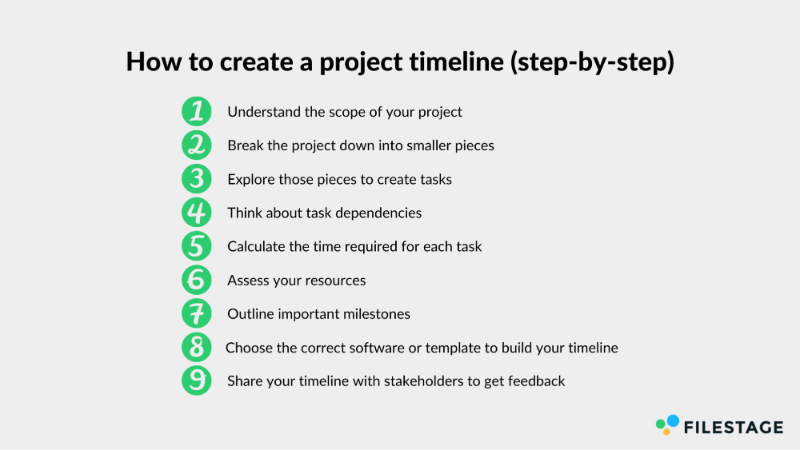
1. Understand the scope of your project
As a marketing project manager, your project will begin with a brief or project plan. To make sure that your project timeline is accurate and correct, you need to take good care of these foundations.
First, you should develop a clear understanding of the brief and everything that is required. This can take some time and requires close consultation with your client. It is critical, though, that the scope of the project is as accurate and tasks are as detailed as possible.
You should produce a project scope announcement that everyone understands. This will be a statement that succinctly and accurately sums up the goal of the project.
For example: “Our team will design, develop, and populate a new blog on the website of our client.”
2. Break the project down into smaller pieces
Now that you have an idea of the big picture, it’s time to zoom in and see which smaller pieces actually make up that large statement.
In our example, the project manager is going to coordinate the design, development, and content of a new blog. There are a lot of moving pieces here and a lot of constituent parts. The project will require, for example, the following parts:
- A theme for the blog
- Visual guidelines
- Tone of voice guidelines
- A content plan
- Content for the blog
This will always vary according to the project scope statement that you defined, but it’s important that you think about every sub-deliverable that you will need to provide to deliver the whole.
3. Explore those pieces to create tasks
Now that you have your sub-deliverables, it’s time to dig deeper into the timeline. Let’s take the theme, for example. Your entire team will have to complete the following work to create that sub-deliverable:
- Conduct competitor research
- Brainstorming and feasibility testing
- UI & UX attention
- Design of wireframes
- Development of the theme
- Quality testing
Of course, this might vary according to the specifications of the project. But this gives you an idea of how you need to start thinking about the constituent tasks that make up the sub-deliverables and helps you plan the following steps.
4. Think about task dependencies
Some tasks cannot begin until others have been completed. The design of the wireframes, for example, might not be able to take place until a key section of the visual guidelines has been created.
These dependencies mean that your project has a definite natural order. Depending on the complexity of your project, though, this can become quite a headache. (There are some tools that can help, though, and we will look at those soon.)
Once you have organized which tasks need to occur first, you will find that your timeline is beginning to adopt a more conventional shape.
5. Calculate the time required for each task
The tasks are now in a nice neat order, but how far apart do they need to be?
You need to call upon your marketing experience to create accurate estimations for each of the tasks in your project. You might find, for example, that you need to allow three weeks for the development of the wireframes, but just a few days for quality testing.
As you space out the tasks on a horizontal line, you will begin to see that you naturally develop an estimation for how long a project might take. Creating accurate estimations is no easy task, and many marketing managers consult with a range of professionals to get a better idea.
6. Assess your resources
Now that you know what you need and how long it will take, it’s time to fill in the gaps. The best marketing managers are able to take the abilities and preferences of each of their team member into account. This can help to create more accurate timelines.
Balancing responsibilities is tough. Even though a given task might take four hours, for example, unexpected occurrences can derail the process, and this can have an impact on other areas of the project.
Project management demands that you think on your feet and make the best of the project management tools that are available to you.
7. Outline important milestones
Your project plan timeline is almost there, but now you need to think about tracking the progress of the project at regular intervals. This is a very important step, given that it means your team can get the feedback and approval it needs far before the final deadline.
This means that if necessary, you can take the initiative to adjust plans to ensure that everything stays on track. Milestones should be placed regularly and based around certain key moments, like the completion of a large task.
8. Choose the correct software or template to build your timeline
You have planned out your high-level timeline, but now it’s a question of actually putting it together in a way that is logical, accessible, and adaptable. Until now, this was easier said than done. But there are many quality project management applications available to you now.
9. Share your timeline with stakeholders to get feedback
As we have seen from the project management timeline use cases, communication is key when you create a project. You need to make sure that all stakeholders agree with the end date as well as individual milestones. It is important that team leaders or managers regularly gather feedback and find common denominators between conflicting deadlines, tasks, and responsibilities within a project.
While not each and every task needs to be communicated with all team members, it is key that dependencies are identified and communicated as such. If important stakeholders are not able to deliver on time, your whole project might be at risk. Therefore, make sure to get approval for your project timeline from all important stakeholders.
The question is how to efficiently share, discuss, and get approvals on your project management timeline. Obviously, writing lengthy emails is prone to failure. This is where online proofing software comes into play.
With a tool like Filestage, you can upload your project timeline to a platform where you can share it with all involved stakeholders. Then they can review, discuss, and approve the file in one place at the same time. This avoids contradictory feedback and makes real-time discussion between reviewers possible. Through increased transparency, you receive feedback much faster and with better context, which streamlines the entire process.
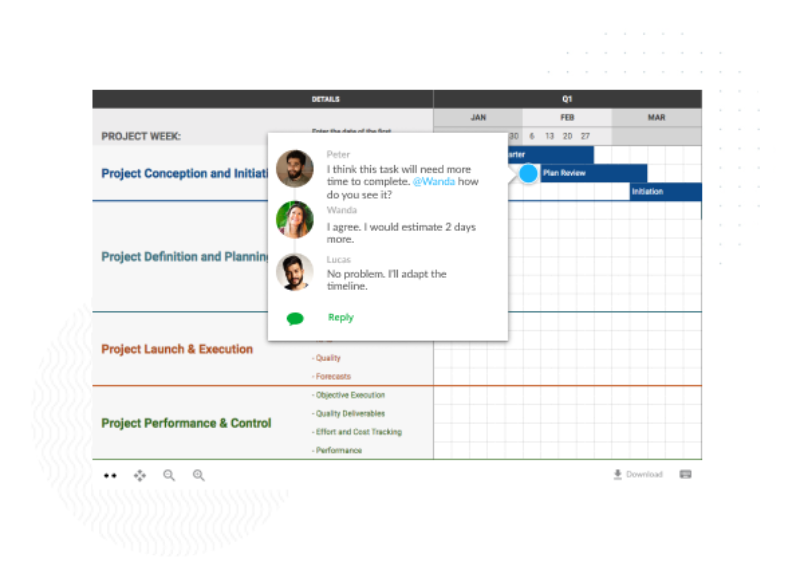
Filestage project timeline template
Hoping to create your own project timeline using Google Sheets? We have put together this free project timeline template to help you get started.
You will find that the entire project has been broken down into a series of key stages, and each one of those into smaller parts. Those smaller tasks have been plotted along with the chart, showing how long each should take and when you should expect them to be finished.
You are free to adjust the tool according to your needs, switching out the key project phases to match with your own internal procedures. Once those have been accurately defined, it’s a matter of populating the chart with the smaller tasks.
Deciding how granular to go at this stage is tough and depends on your own preferences. If you go too granular, you will find that your project timeline quickly becomes inflexible and difficult to read. Too broad, however, and you might find that the utility of the tool has started to vanish.
Here are some key tips when it comes to using this tool:
- Don’t be afraid to adjust it according to your specific needs.
- Feel free to adjust the design to fit your brand identity.
- Get opinions from the rest of the team.
- Be as precise as possible, but leave room for some flexibility.
We hope that the tool helps you and we are certain that you will create some really stunning project timelines that make your project a complete success.
Project timeline software
You will find that there are many project timeline software options on the market. Here is a closer look at the key timeline options that might fit your project management needs.
Monday
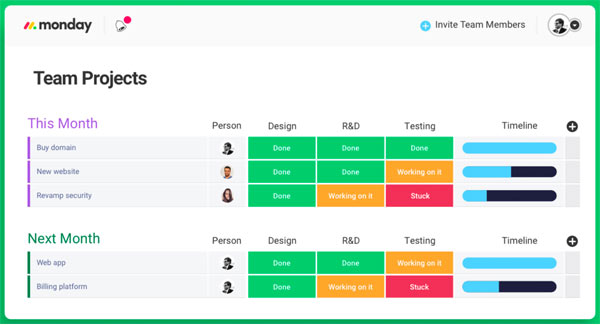
Monday is a visual tool that makes it possible for marketing managers to plan, organize, and track their team’s projects and timelines. The platform prides itself on easy onboarding and fast adoption, offering six views to help teams keep up with the project plan and adjust for the future.
“Since our projects bring teams from various departments, it’s great to have a central place to communicate and collaborate. Monday.com has tremendous potential, but we also find some challenges with it, including sub-tasks, notifications, and the pricing.”
Teamwork Projects
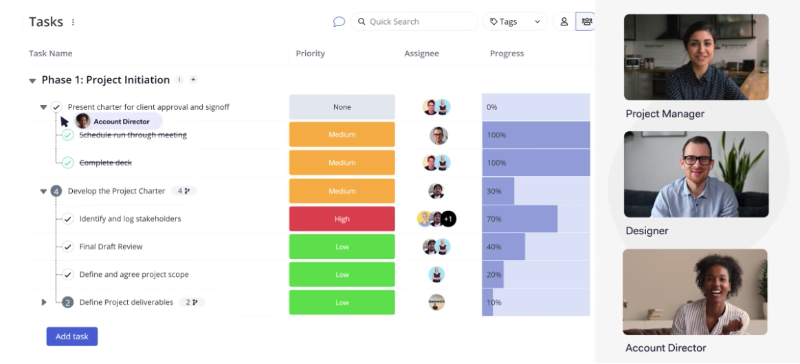
Teamwork Projects is a cloud-based project management solution that helps businesses and managers manage the various parts of a project to control objectives, business processes, and deliverables. The features include task lists, time tracking, high-level timelines, and more.
“It’s awesome how the projects and tasks are set up and all the actions you can take on them to keep things logged and up-to-date and organized. I do wish there was a calendar view of all the tasks assigned to you so you could see the density on how stuff is assigned and when, so it’s easier to work ahead.”
ProjectManager.com
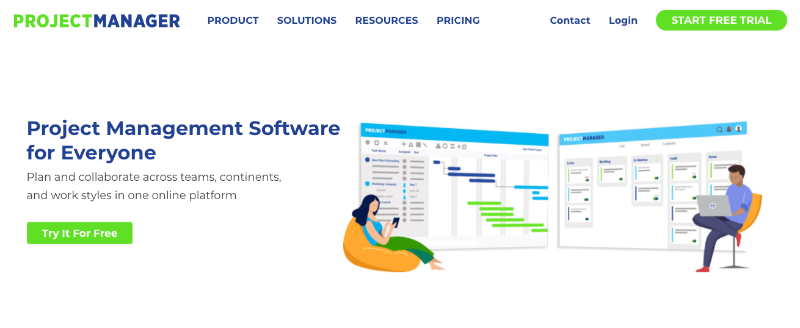
ProjectManager is designed to help teams plan, track, and collaborate online. A range of real-time bar charts and dashboards help demonstrate the progress that has been made on projects and what is next.
“ProjectManager.com is very easy to use. We were able to get up and running in a very short amount of time and now we have approximately 300 projects that we are managing and about 70 resources.”
Workzone
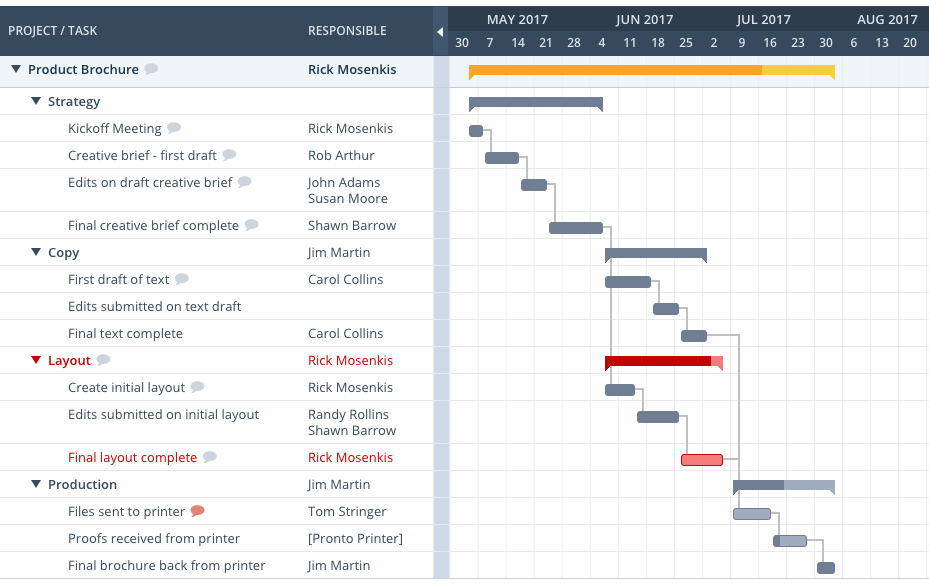
Workzone describes itself as being robust and powerful, yet simple to use. The timeline and chart tool helps managers to track progress and team members, while also measuring and improving results.
“The system provides a great high-level status view, with the ability to drill down into specifics. Navigation through the system could be improved in some areas, such as returning to where you were on a page after making a change, as opposed to a full page refresh.”
TeamGantt

TeamGantt aims to help marketing managers plan their projects in mere minutes using Gantt charts. This online project management software makes the creation of these charts simple to handle project scheduling and management with ease.
“Once you start setting up your projects, you find that it has highly advanced features and can scale heavily to meet larger requirement sets. There are small issues with usability, which feel largely rooted in the fact that the system runs in a web browser.”
Forecast
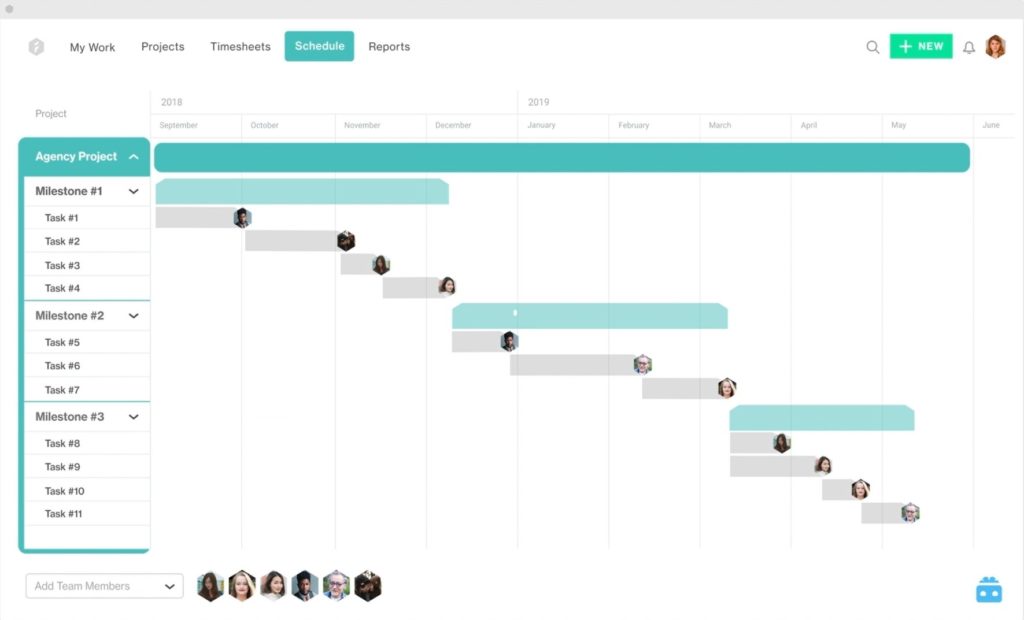
Forecast is a project management platform that fully automates project planning and scheduling. Forecast’s AI turns a task list into a solid project timeline with estimations, people, and expected delivery dates assigned. It applies your historical data to reduce the administrative overhead to a minimum. On top of resource-planning functionality, Forecast has a budget tab, able to do the math for you as well.
“I am using Forecast to program time across multiple projects and clients. It allows me to quickly see the proportion of time allocated to each client, and for every project, track progress to completion. It provides that “bird’s eye” view on when I am getting behind on something.”
Three must-have features of project timeline software
Before you choose a project management tool for creating timelines, you should verify whether the features are in line with your specific needs.
No matter which option you choose, the following four must-have features are indispensable for almost every project timeline software.
Collaboration features
As pointed out earlier, you need a smooth communication structure to create a plan. Advanced project management timeline software should not only enable you to plan a project and create a high-level timeline. It must include communication features to keep all stakeholders up-to-date.
Your tool should enable all stakeholders to communicate on one single platform and receive automated notifications whenever changes in start or end dates of tasks or milestones are made.
Customizable timelines (including task dependencies)
Even though there are similar projects, you can be pretty sure that your project will have unique tasks, which need their own individual solution.
In order to structure a project, it is necessary to define due dates and describe the milestones that stakeholders need to complete.
Therefore, you should look for software solutions with highly customizable timelines, so that you can plan and create your individual project from start to finish.
Resource and task management tools
Creating a project timeline and implementing tasks requires resources. Therefore, your software solution should at least have basic resource and task management functions, which allow you to assign team members to specific milestones and tasks within a project.
More advanced features would include a workload overview of all team members, so that tasks can be distributed equally.
Five project timeline templates
Interested in exploring a range of alternative options? Here is a closer look at five additional project timeline templates.
Gantt chart Excel template by TeamGantt
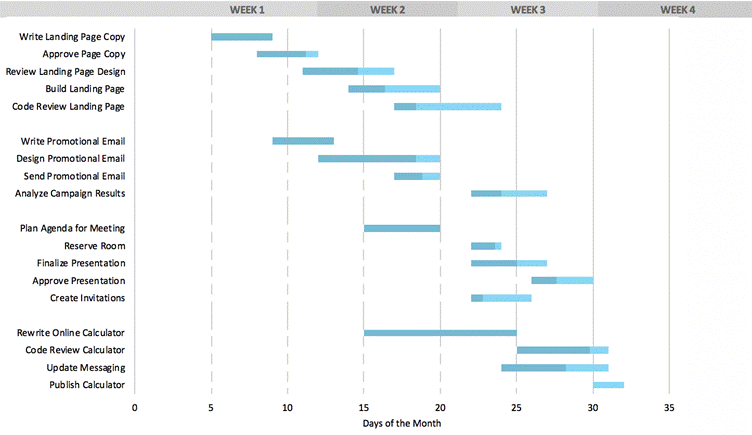
TeamGantt was kind enough to put together a free Gantt chart Excel template for project managers. The Excel template can save teams a lot of time and remove many tedious planning tasks that become a chore to complete. The project timeline template can be downloaded for free and it is compatible with Excel versions 200 and up on both Mac and Windows.
Project timeline template by Bitrix24
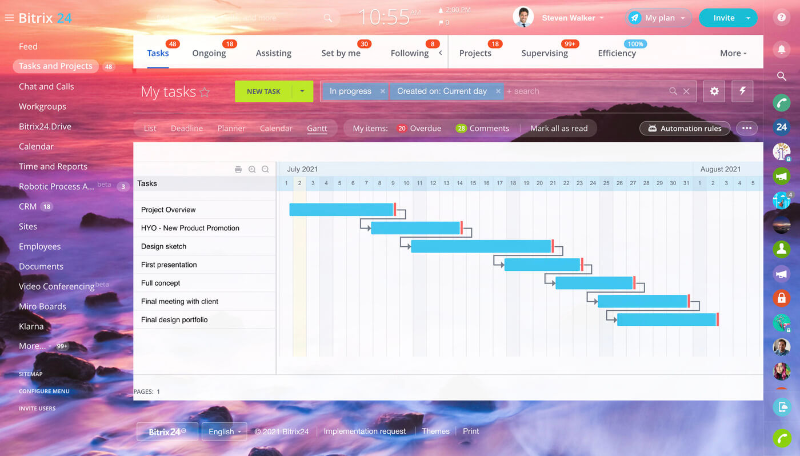
Bitrix24 is a free project management solution that comes equipped with some preloaded project timeline templates. This high-level timeline view can help managers to make the most of a Gantt chart to see their projects in a new way. Dependencies are also covered, meaning that when one task is adjusted, it is reflected throughout the project.
Project management timeline template by Lucidchart
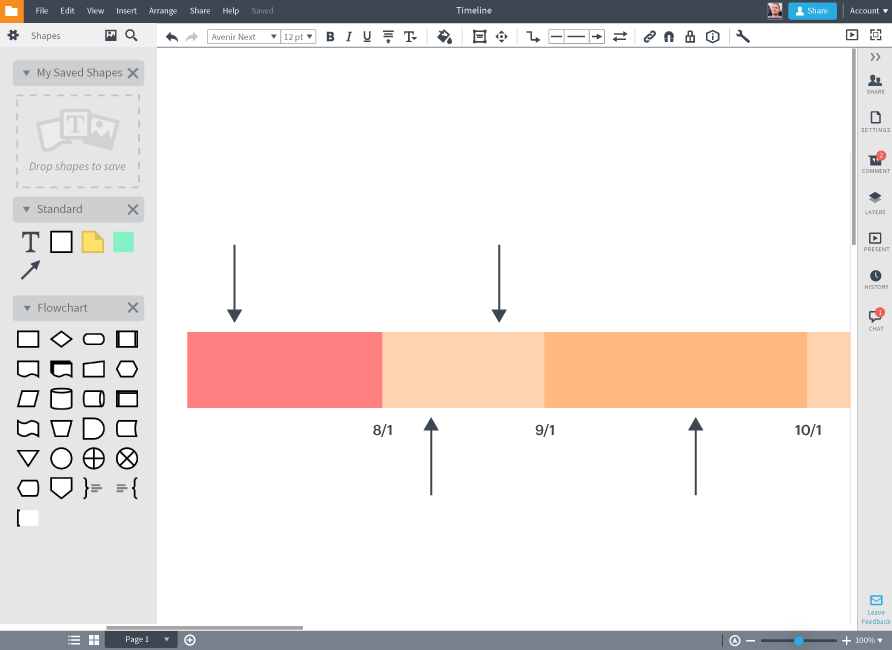
At the end of this article, Lucidchart offers a variety of project management timeline templates through its platform. Marketing managers are able to log in to the platform to access the templates, which are intended to help with managing multiple teams, large projects, and those projects with a range of milestones.
Project timeline template by HubSpot
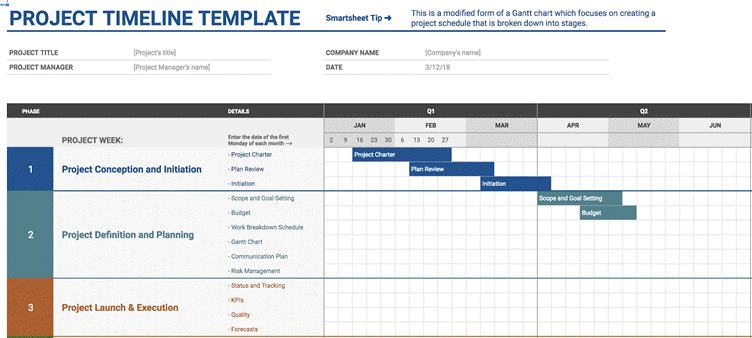
When used effectively, Google Sheets has the potential to be a project management powerhouse (along with the rest of the G Suite), and the Sheets app can be used to create project timelines. HubSpot has kindly curated a list of the best Google Sheets templates. These are free and available to marketing project managers.
Project timeline template by My Product Roadmap
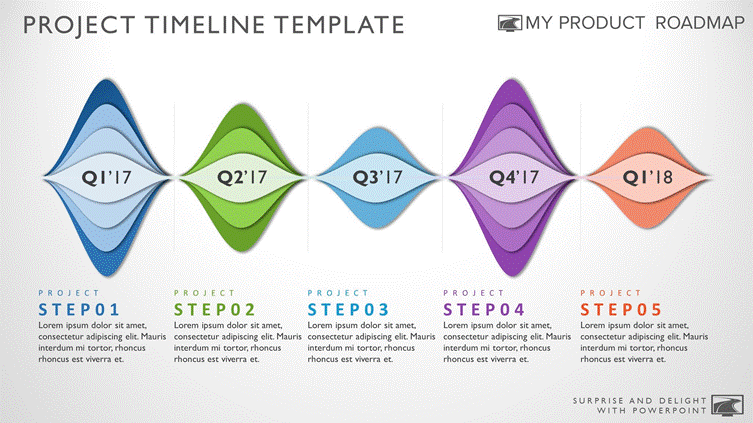
If you are looking to impress with a beautiful and descriptive project timeline template, then you might want to consider using this project timeline template for PowerPoint that was kindly provided by My Product Roadmap. Project managers are free to add and edit their data so that the project timeline template caters to specific company needs.
Project timeline examples
Looking for some serious inspiration? Here is a closer look at some of the best project timeline examples.
Project sprint timeline example by Venngage

If you are particularly concerned about the aesthetics of your project timeline, then this collection of project timeline best practices will help you to put together a creative and visually engaging timeline that will delight your project team.
This isn’t just about aesthetics, of course; there are great practical reasons to put a lot of effort into the design of your project timeline. You can also pick up some tricks on how to make your high-level timeline a document that is pleasant to look at and supports your team.
Project timeline example by Miro
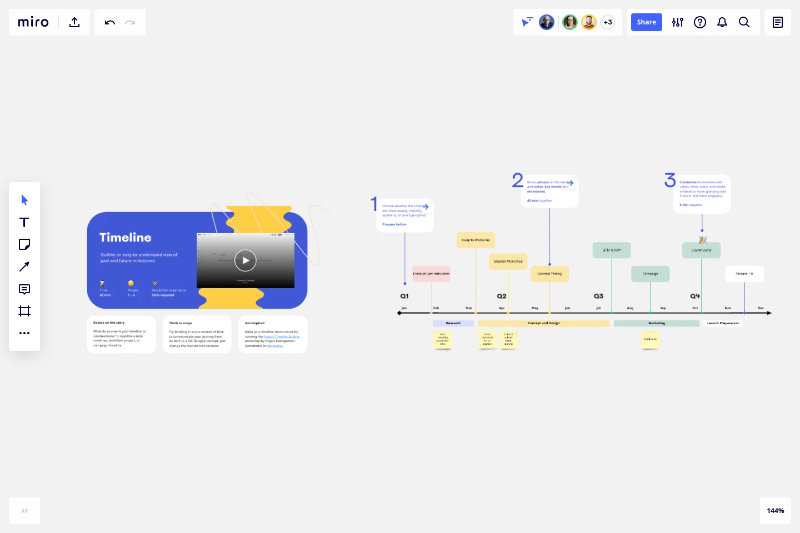
This is an effective project timeline template that values simplicity. It can be used by project managers to create descriptive and clear project timelines that inspire the team. To access the tool, though, you will have to create an account. If you are looking for a simple tool, it could be worth investigating in more depth.
Specialized timelines for professionals by Office Timeline
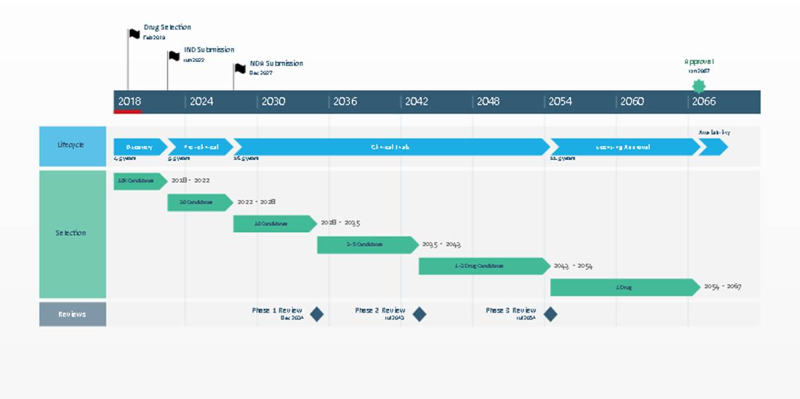
Projects vary greatly by industry. Therefore, it is worth taking a look at templates that cater to specific industries. For instance, the pharmaceutical product discovery timeline can take decades, as possible long-term effects and strict regulations require intensive studies before the product can be launched.
The timeline template does not use Excel, but the Office Timeline PowerPoint add-in, a Gantt chart, as well as a timeline maker. More industry-specific templates can be found on Office Timeline.
What are the different timeline types?
After you have created your scope statement, it is worth taking a look at different ways to create a project timeline and work breakdown structure.
Gantt charts
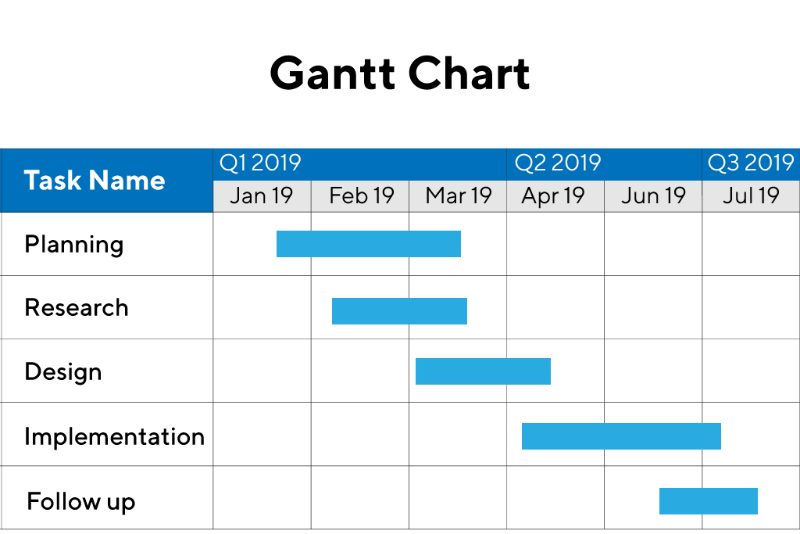
Gantt charts certainly belong to the most popular timeline types. The advantage of a Gantt chart lies in its simplicity, as dependency relationships and the current project progress can be seen at one single glance. Different activities are represented with bars, whose length shows the duration from start to end.
Horizontal charts
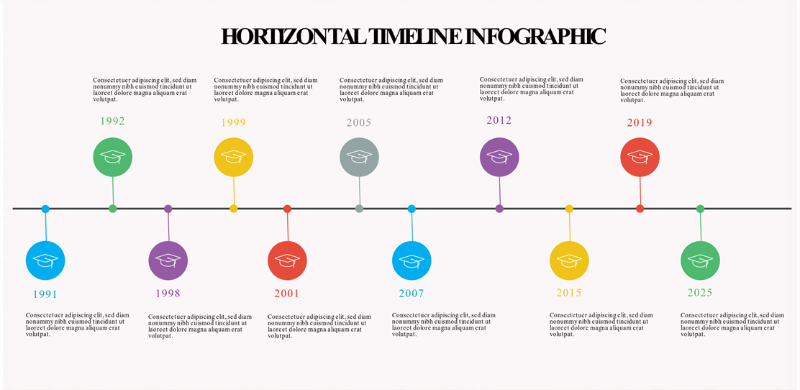
As the name suggests, horizontal charts display different milestones and project tasks in a horizontal progression and chronological order. Horizontal charts can be used for simple projects with clear dependencies, in which one task starts only after the previous one has been completed.
Vertical charts

While horizontal charts display the timeline of events on the x-axis, vertical charts show milestones and tasks on the y-axis in chronological order. Oftentimes, more events are shown at the bottom, while the top section of the timeline shows the final deliverables.
Interactive charts
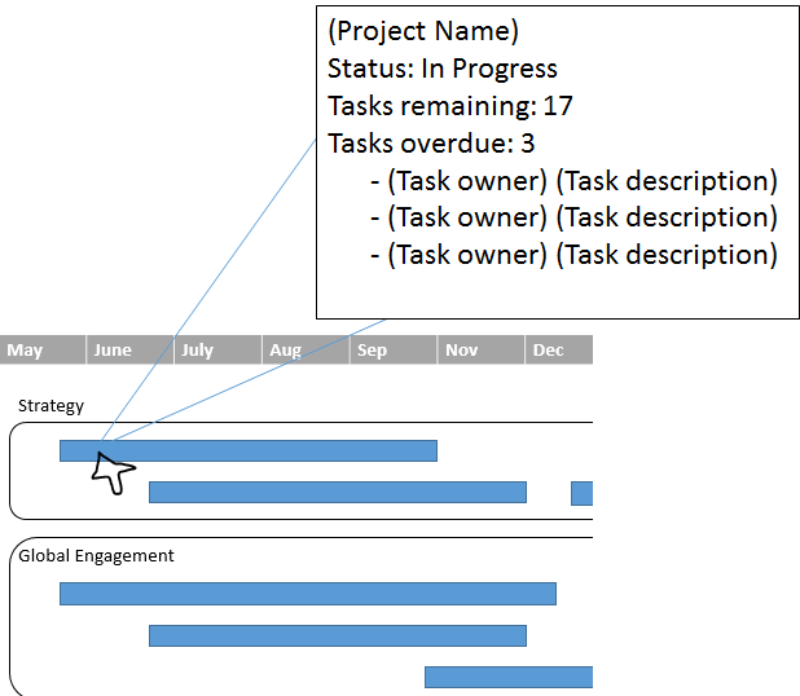
Software solutions offer interactive charts to provide an even better overview of your progress without compromising simplicity. For instance, hovering over certain tasks or milestones may open up the current progress, resources needed, or other crucial project data.
Conclusion
It should be clear by now that timelines are an integral part of the project, as creating a high-level timeline determines all future actions. Therefore, it is your responsibility to create a project plan containing all deliverables, solutions resources, key milestones, and tasks from start to finish.
You need to plan your project and tasks with project management timeline software and best practices to streamline your workflows, increase efficiency, and ultimately deliver higher quality outcomes at a much faster pace.
We hope that this article has helped you to see the value of a great project timeline, and equipped you with the knowledge and tools to put one together for your project!

